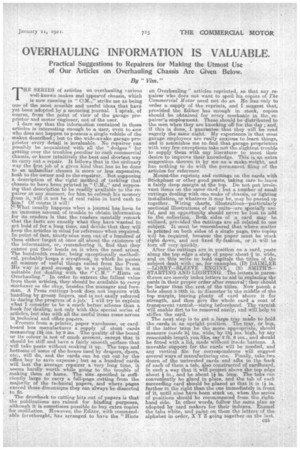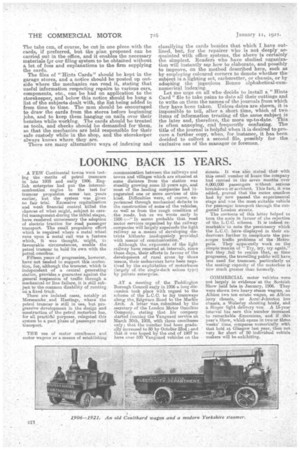OVERHAULING INFORMATION IS VALUABLE.
Page 13

Page 14

If you've noticed an error in this article please click here to report it so we can fix it.
Practical Suggestions to Repairers for Making the Utmost Use of Our Articles on Overhauling Chassis Are Given Below.
By "Vim."
THE SERIES of articles on ov.erhauling various well-known makes and typesesf chas.sis, which
is now running in " C:M.," strike me as being one of the most sensible and useful ideas that have yet been adopted by a motoring journal. I speak, of course, from the point of view of the garage proprietor and motor engineer, not of the user.
I dare say that the information containe,d in. these articles is interesting enough to a user, even to One
Who does not happen to possess a single vehicle of the makes described but to the wide-awake garage proprietor every detail is invaluable. No repairer can possibly be acquainted with all the " dodges " for getting over the troubles peculiar to each commercial chassis, or know intuitively the best and shortest way to carry out a repair. It follows that in the ordinary way the #rst job a a given kind that. has to be done to an unfamiliar chassis is more or less expensive, bath to the owner and to the repairer. But supposing
a description of the right method of tackling that chassis to have been printed in " C.M.•'" and suppos
ing that description to be readily available to the repairer at any moment, for him to -refresh his memory from it, will it not be of real value in hard cash to ihim,? Of course it will I te'sWhat usually happens when a journal has been to an immense amount of trouble, to obtain information • for its readers is that the readers mentally remark that the facts are exactly what they have wanted tis get hold of for a long time, and decide. that they will keep the articles in min,d for reference when required. In point of fact, ninety-nine men out of a hundred of them either forget at once all about the existence of the information, or, remembering it, find that they cannot put their hands on it when the need arises. The hundredth reader, being exceptionally methodi cal, probably keeps a scrapbook, in which he pastes all manner of useful things culled from the Press. His way is good enough up to a point, but is not suitable for dealing with the i" C.M." "Hints on Overhauling!' In. order to extract the fullest value
from those articles they should be available to every mechanic in the sit'op, besides the manager and foreMan. A Press cuttings book does not improve with
handling by greasy fingers, and is not easily referred to during the progress of a job. I will try to explain what I consider to 'be a much better scheme than a book for dealing, not only With this special series of articles, but also with all the useful items come across in technical and other papers. Procure from, a printer, paper warehouse, or .cardboard box manufacturer a supply of stout cards measuring.12-4 ins. by 9 ins. -The quality of the board or its colour is not of* much account, except that it should be stiff and have a fairly smooth surface that will take paste without soaking it up. The tops and bottoms of some of the boxes used by drapers, dyers, etc., will do, and the cards can be cut out by the office, boy to save expense; but as a. hundred cards will last the avera.ge repairer a very long time it seems hardly worth while going to the trouble of making them at home. The sizespecified is sufficiently large to carry a full-page cutting from the majority of the teshnieal papers, and where pages exceed those dimensiens they can always he dissected to fit.
The drawback to cutting bits out of papers is that the publications are ruined for binding purposes, although it is sometimes possible to buy extra copies for mutilation. However, the Editor, with commendable forethought, has arranged to have the "Hints
on Overhauling " articles reprinted, so that any repairer who does not want to spoil his copies of The Commercial Motor need not do so. He has only to order a supply of the reprints, and I suggest that, provided the Editor has enough in stock, copies should be _obtained for every mechanic in the, repairer's employment. These should be distributed to the men when they are knocking off for the day ; and, if this is done, I guarantee that they will be read eagerly the same night. My experience is that most garage employees are really animus to learn things, and it astonishes me to find that garage proprietors with very few exceptiOna take not the slightest trouble to supply them with any literatureto meet their desire to improve their knowledge. This is an extra suggestion thrown in by me as a make-weight, and has nothing to do with the permanent filing of the arfieles for reference.
Mountsthe reprints and cuttings on the cards with Stiekphast or other good paste, taking care toleave a fairly deep margin at the top. Do not put irrelevant items on the same card; but a number of emall cuttings dealing with one make of chassis, or lighting installation, or whatever it may be, may be pasted up together.. Wiring charts, illustrations—particularly sectional illustrations of car units—are specially useful, and an opportunity should never be last to add to the collection. Both sides of a card may be utilized, provided the cuttings are all related to one subject. It must be remembered that where matter is printed on both sides of a single page, two copies will be required, because the paper must be stuck right down, and not fixed fly-fashion, or it will be tarn off very quickly.
After the cuttings are in position on a card, paste along the top edge 11 Strip of paper about in. wide, and on this write in bold capitals the titles of the subject dealt with ; as, for examples, (D) DAIMLER —LORRY--SLEEVE ENGINE; (S) SMITH'S— STARTING ANDLIGETTING. The letters in parentheses are merely index letters to aid in replacing the cards in their proper order after removal they should , be larger than the rest of the titles. Now punch a hole about 3-16th in. in diameter in the middle of the top margin, leaving plenty of card above it. for strength, and then give the whole card a coat of transparent varnish—sizing beforehand, The varnish will enable dirt to be removed easily, and -will help to stiffen the card. The next step is to get a large tray made to hold the cards in an upright position. The tray, or box, if the latter term be the more appropriate, should measure inside 9 ins, wide, by 134 ins, high, by any reasonable length -you like, say 2 ft. 6 ins., and should be fitted with a lid, made without inside battens. A movable support for the cards will be needed, and any vertical file for correspondence will suggest several ways of manufacturing one. Finally, take two dozen of the untreated cards and affix to the back of each of them a tab, also constructed of cardboard, in such a way that it will project above the top edge about in., and he about 14 m. long. The tabs can conveniently be glued in place, and the tab of each succeeding card should he placed so that it is a in. further te the right than the one immediately in front of it, until nine have been stuck on, when the series of positions should be recommenced from the righthand side. In other words, follow the same plan as adopted by card makers for their indexes. Enamel the tabs ishith, and paint on them the letters of the alpha-bet in order, X Y Z going together on the last.
The tabs can, of course, be cut in one piece with the cards, if preferred, but the plan proposed can be carried out in the office, and it enables the necessary materials ter our filing system to be obtained without a lot of fuss and explanations to the firm supplying the cards.
The files of 'Hints Cards" should be kept in the garage stores and a notice should be posted up outside where tlie mechanics can read it, stating that useful information respecting repairs to various cars, components, etc., can be had on application to the storekeeper and below this notice should be hung a list of the subjects dealt with, the list being added to from time to time. The men should be encouraged to draw the cards from the stores before beginning jobs, and to keep them hanging on nails over their benches while working. The cards should be treated as tools, and checks should be demanded for them, so that the mechanics are held responsible for their safe custody while in the shop, and the storekeeper always knows where they are.
There are many alternative ways of indexing and classifying the cards besides that which I have outlined, but, for the repairer who is not deeply'% acquainted with office systems, the above is certainly the simplest. Readers who have studied organization will instantly see how to elaborate, and possibly to improve, on the method described here, such as by employing coloured corners to denote whether the subject is a lighting set, carburetter, or chassis or by adopting the ingenious Renee alphabeticL-curanumerical indexing.
Let me urge on all who decide to install a "Hints Card" file to take pains to date all their cuttings and to write on them the names of the journals from which they have been taken. Unless dates are shown, it is impossible to tellz after a short time, which of two items of information treating of the same subject is the later and, therefore, the more up-to-date. This is often annoying, and frequently confusing. The title of the journal is helpful when it is desired to procure a further copy, when, for instance, it has been decided to collect a second file, possibly for the exclusive use of the manager or foreman.
































